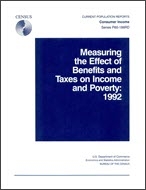Measuring the Effect of Benefits and Taxes on Income and Poverty: 1992
Measuring the Effect of Benefits and Taxes on Income and Poverty: 1992
Note To Users
The estimates in this report are controlled to national population totals by age, race, sex, and Hispanic origin. The population controls used in the preparation of estimates for the years 1991 and 1992 are based on results of the 1980 census. The estimates in this report for 1991 and 1992, therefore, may differ from estimates that would have been obtained using 1990 census results brought forward to the survey date. Population controls incorporating 1990 census results will be used for survey estimation beginning in 1994.
The Census Bureau has developed three additional definitions of income for 1991 and 1992. These include: 1) a fully developed tax and noncash income definition without the value of Medicare and Medicaid, 2) an after-tax income definition without any other adjustments excluding the Earned Income Tax Credit (EITC), and 3) an after-tax income definition with EITC. A complete description of these definitions can be found in appendix J.
Introduction
This report presents alternative measures of income and poverty for the calendar year 1992. These data were derived from information collected in the March 1993 Current Population Survey (CPS) conducted by the Bureau of the Census, with input from other data sources such as Internal Revenue Service, US. Department of Agriculture, Department of Labor, Bureau of Labor Statistics, and Health Care Financing Administration.
All demographic surveys, including CPS, suffer from undercoverage of the population. This undercoverage results from missed housing units and missed persons within sample households. Compared to the level of the 1980 Decennial Census, overall CPS undercoverage is about 7 percent. Undercoverage varies with age, sex, and race. For some groups, such as 20 to 24 year old Black males, the undercoverage is as high as about 35 percent. The weighting procedures used by the Census Bureau partially correct for the bias due to undercover age. However, its final impact on estimates is unknown. For details, see appendix D.
Traditionally, income and poverty data presented in Census Bureau reports have been based on the amount of money income received during a calendar year before any taxes and excluding capital gains. This definition of income is narrow and does not provide a completely satisfactory measure of the distribution of income. The omission of data on taxes, realized capital gains, and the value of noncash benefits has an effect on comparisons over time and between population subgroups.
The official income definition reflects the content of the March Current Population Survey questionnaire. The March questionnaire contains no questions about taxes and, until 1980, contained no questions about the receipt of noncash benefits. Since March 1980, the questionnaire has included items on the receipt of benefits from government programs (e.g., foodstamps, housing assistance, Medicare, and Medicaid) and from employers (e.g., health insurance).
In the early 1980's the Census Bureau embarked on separate research programs to examine: 1) the effect of government noncash benefits on poverty and 2) the effect of taxes on income distributional measures. An expansion and integration of these research efforts led, in December 1988, to the publication of a report entitled Measuring the Effect of Benefits and Taxes on Income and Poverty: 1986 (Current Population Reports, Series P-60, No. 164-RD-1). That report presented calculations showing how income and poverty estimates changed when specific taxes were deducted and specific benefits were added to the income definition. This report presents updated estimates of the incremental effect of benefits and taxes on income and poverty for 1992.
The 1992 Federal tax estimates in this report are based, in part, on 1991 IRS statistics, since 1992 IRS data were not available in time to be used for deriving 1992 estimates. For that reason, the 1992 Federal tax estimates in this report should be considered preliminary.
Others in Series
Publication
Publication
Publication






